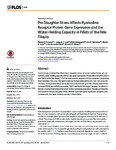Please use this identifier to cite or link to this item:
http://www.alice.cnptia.embrapa.br/alice/handle/doc/1026757| Title: | Pre-Slaughter stress affects ryanodine receptor protein gene expression and the water-holding capacity in fillets of the nile Tilapia. |
| Authors: | GOES, E. S. R.  LARA, J. A. F. de   GASPARINO, E.   DEL VESCO, A. P.   GOES, M. D.   ALEXANDRE FILHO, L.   RIBEIRO, R. P.   |
| Affiliation: | ELENICE S. R. GOES, UEM; JORGE ANTONIO FERREIRA DE LARA, CPAP; ELIANE GASPARINO, UEM; ANA P. DEL VESCO, UEM; MARCIO D. GOES, UFPR; LUIZ ALEXANDRE FILHO, UEM; RICARDO P. RIBEIRO, UEM. |
| Date Issued: | 2015 |
| Citation: | Plos One, v. 10, n. 6, p. 1-14, junho, 2015. |
| Description: | Current study evaluated the effect of pre-slaughter stress on serum cortisol levels, pH, colorimetry, water-holding capacity (WHC) and gene expression of ryanodine receptors (RyR1 and RyR3) in the Nile tilapia. A 3x4 factorial scheme experiment was conducted comprising three densities (100, 200, 400 kg/m³) with four transportation times (60, 120, 180, and 240 minutes).Transportation times alone reduced cortisol levels up to 180 minutes, followed by increased WHC and mRNA expression, RyR1 and RyR3 (200 kg/m³ density). No effect of density x transportation time interacted on the evaluated parameters. Results provided the first evidence that pre-slaughter stress affected ryanodine gene expression receptors and, consequently, the water-holding capacity in tilapia fillets. |
| Thesagro: | Tilapia Peixe Stress |
| NAL Thesaurus: | Fish meat Slaughter fish |
| Keywords: | Live fish Fish behaviour |
| DOI: | 10.1371/journal.pone.0129145 |
| Type of Material: | Artigo de periódico |
| Access: | openAccess |
| Appears in Collections: | Artigo em periódico indexado (CPAP)  |
Files in This Item:
| File | Description | Size | Format | |
|---|---|---|---|---|
| 2015rianodinatilapia.pdf | 985,21 kB | Adobe PDF |  View/Open |









